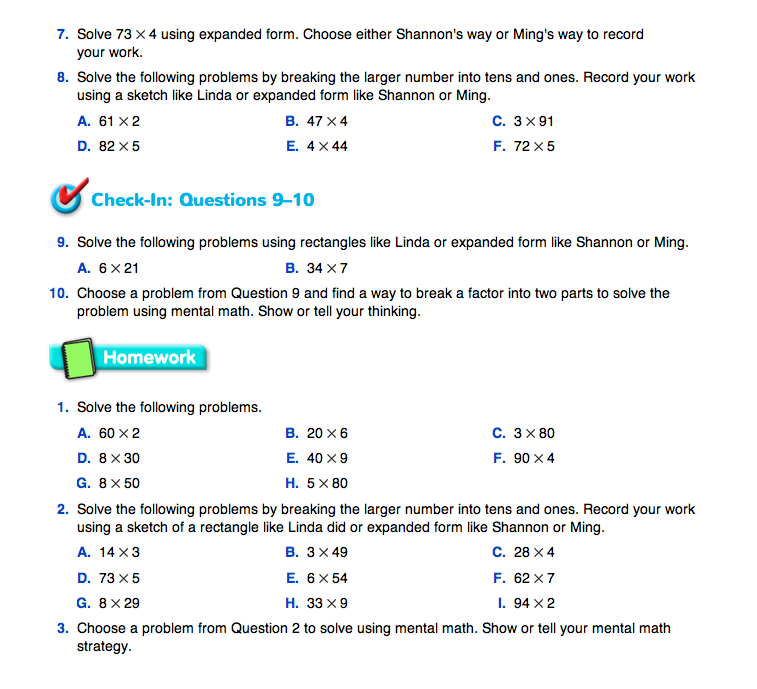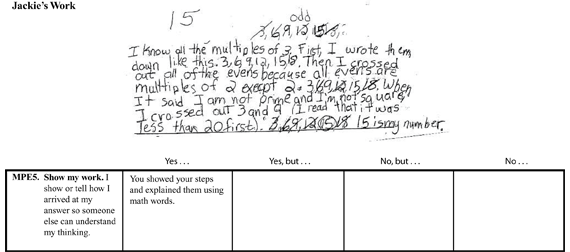Ask students to complete Questions 8A–F in the Student Guide and then ask volunteers to show the class how they solved them. Ask for solutions that show different recording methods, including sketching a rectangle and using expanded form. As students show their solutions, ask the meaning of the numbers they write down.
Have students complete Check-In: Questions 9–10 using break-apart and expanded form methods.
Use Check-In: Questions 9–10 in the Student Guide to assess students' abilities to break products into the sum of simpler products to solve 1-digit × 2-digit multiplication problems [E9].
Unit 3 Test. The Unit 3 Test in the Teacher Guide provides an assessment of the central concepts of this unit. Questions 1–10 are straightforward test questions, and feedback to students can be provided using the Feedback Box at the end of the test.
Question 11 is a number riddle similar to those in Lesson 8 that give clues using the terms multiple, factor, prime, and square. This question can be used to assess whether students can explain their solution steps fully [MPE5]. See Figures 3, 4, and 5 for three explanations that have been evaluated using the Math Practices Expectation 5 and a Feedback Box.
Before students begin working on Question 11, ask:
- What should you include in your explanation so someone else can understand your thinking? (Students may respond that they need to show their steps and use the terms multiple, factor, prime, and square to explain why they made the choices they did.)
After students have completed a draft of their explanations, have them set their work aside momentarily.
Students Review Student Work Samples. Distribute a sample of student work to each small group of students. Use either student work from your own class or the Question 11 Number Riddle Masters.
Set expectations by asking:
- Did the students show how they arrived at their solutions? Are any steps missing?
- Can you follow each step so you could solve the riddle the same way they did?
- Did they use the terms multiple, factor, prime, and square?
- Do you know why the numbers are listed, circled, or crossed out?
- Is it clear what number is the final answer to the riddle?
- What questions do you want to ask so you understand the solution better?
- Which box (Yes … Yes, but …; No, but …; or
No …) best matches how each student explained his or her thinking? What would you write in the box?
You may choose to use work from your own class for student groups to evaluate and provide feedback using the Feedback Box.
If you decide to use the student work on the Question 11 Number Riddle Masters, distribute Nicholas's and Shannon's work to half the groups and Jackie's work to the other half.
Have student groups evaluate the student work using the Feedback Box and discuss their choices.
Students may then revise their own explanations in a different color pen before you evaluate them.

Ask students to complete the Unit 3 Test pages individually. Questions 1–10 assess students' progress towards the Expectations below:
- E1.
- Represent and solve multiplication and division problems using rectangular arrays.
- E2.
- Determine whether one number is a multiple of another number.
- E3.
- Find all the factors of a number.
- E4.
- Identify prime numbers.
- E5.
- Identify square numbers.
- E6.
- Find the prime factorization of a number.
- E9.
- Break products into the sum of simpler products to solve multiplication problems (applying the distributive property of multiplication over addition).
Use Question 11 and the Feedback Box on the same page to evaluate students' abilities to meet the Math Practice Expectation below:
- MPE5.
- Show my work. I show or tell how I arrive at my answer so someone else can understand my thinking.
Transfer appropriate documentation from the Unit 3 Assessment Record and the Math Facts Class Record to students' Individual Assessment Records.

















